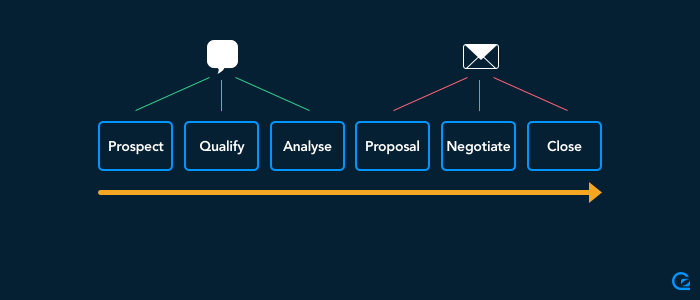
Whether you’re an online business or not, the traditional way of selling has changed. The methods we use to communicate have shifted and that has impacted the way we can deal with prospects.
How do you apply conventional sales techniques, usually applied to in-person or telephone communications, to a prospect that is behind a computer on the other side of the world (or let’s face it just doesn’t answer the phone?).
The way customers communicate has changed
To start, look at your prospect’s habits and the way they communicate now.
A report published by the telecom network O2 showed that, as individuals, we’re spending almost twice as much time on our mobile phones messaging and sending emails (21 minutes), than we do making calls (12 minutes) each day.
Specifically in the workplace, calls are becoming less prevalent with major companies like JP Morgan and Coca Cola deciding to ditch their voice mail systems altogether. Their executives say that most workers, particularly those under 40, have long relied on email, text messaging, instant messaging, or social media to communicate. With millennials continuing to drive this shift in the way we communicate at work, it’s a trend that can only be expected to increase.
The way businesses communicate with customers needs to change
As sales professionals, we can chase the diminishing time our prospects are spending in these channels or we can choose to optimise the way we communicate with them in their preferred channels.
As an online business, one of the best ways to do this is by adding a live chat tool to your website. This not only gives you a channel that your prospects are comfortable communicating in, but also puts you on the shop floor of your online business. Using email as a sales tool won’t be a new concept to anyone, but defining a purpose for it, when using it in conjunction with your live chat tool, will allow you to start to build and optimise a more effective sale process.

Live chat should be used at the earliest part of your sales process, as soon as possible. When a user lands on your site and decides to engage with you, take every opportunity you can to do so. As a sales tool, live chat should be used primarily to listen.
Try to use short, open-ended questions when first starting to talk to a customer through live chat. Questions such as “what attracted you to our website?” or “what were you hoping to use our software for?”.
Key tips for communicating effectively with live chat
- Aim for your chat messages to be no more than 1 to 2 sentences long. This format is better suited to live chat and how your prospect will be used to communicating with similar tools.
- Keep the tone relatively informal (as much as suits your company / brand. ) People are expecting and hoping to talk with a real person.
- Remember to keep the length of your pitch minimal and condensed via live chat. Think more in terms of an elevator pitch.
- Keep in mind that if you are sending multiple messages without a response, the conversation and dialogue will start to seem unnatural.
It’s also one of the best opportunities to qualify a prospect to find out if they are looking to make a decision right now. If they are ready, go ahead and work through the sales process with them taking the opportunity to convert them while they are in the context of your platform.
However, if they aren’t looking to make a decision at this point, don’t feel pressured to quote a price or go into too much pitching while using live chat. If there is a request for more information, take that as an opportunity to establish a dialogue via email as well.
When to employ email as a communication channel
The ideal scenario is to have gathered most of the information needed via live chat before emailing a prospect.
If you ask a wealth of questions in your email, you’re asking the prospect to do too much work when responding and the likelihood is they won’t get back to you.
Is there a budget? Are you speaking with the decision maker? Have you undertaken a proper needs-analysis to establish pain points?
If you’ve used live chat to ask questions and listen well, then hopefully you’ll have some of these answers, and you can use your email to deliver the content they came to you for in the first place. By moving the process to email, you’ll be in a position to put a well considered proposal together, benefiting from the longer format content you can achieve with email.
There can also be multiple stakeholders involved in a buying decision, especially if you aren’t dealing with the decision maker initially. You’ll have one source of information that can be forwarded around internally, or that the decision makers can be linked in on. That way you don’t have to rely on a third party to communicate your product’s benefits based on your chat conversation and you can ensure no important details are lost in translation.
If the proposal is received well, it can also be beneficial to negotiate via email. It’s always useful to keep track of what’s been been offered and agreed. While you have the ability with either tool to look back on conversations, having all the information in one centralised location is useful, particularly again if there are multiple stakeholders involved.
When it comes to converting a prospect, the details of the deal are usually best communicated in an email. In most cases, whatever channel you’re communicating in, you’ll usually be asked to send these details across via email either way. It provides peace of mind and a reference point for everything agreed.
In reality with any process there will be factors that make you deviate from it. Conversations are usually quite fluid between the two channels and so it’s just about identifying what ideally fits where and adjusting to the specific scenario you find yourself in.
Instant, personal, and easy
Using live chat, in conjunction with email, gives you back the one-to-one, personal, and fast interaction, which is lost through the declining use of face-to-face and phone communication. If used correctly, live chat will give you an in-depth understanding of your customer that you can feed into your email communications – ultimately converting more prospects.

